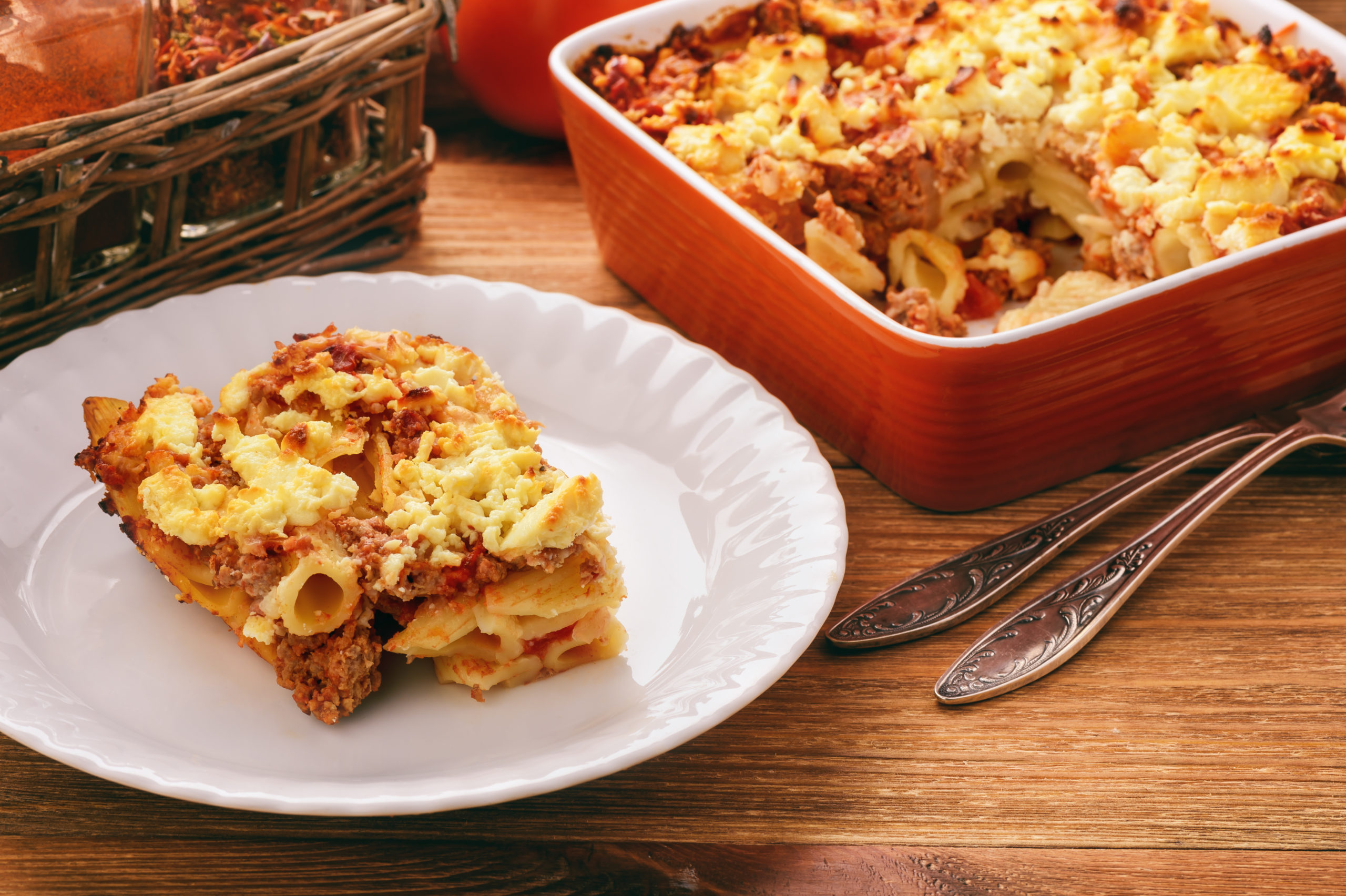Menu
Install the app
How to install the app on iOS
Follow along with the video below to see how to install our site as a web app on your home screen.
Note: This feature may not be available in some browsers.
You are using an out of date browser. It may not display this or other websites correctly.
You should upgrade or use an alternative browser.
You should upgrade or use an alternative browser.
Greek Food, Cooking and Recipe Community
I made pastitsio for a Greek party last weekend!
- Thread starter nadellii
- Start date
1 - 10 of 10 Posts
WOWWW this looks so good!
It does not look like you need it, but for those that are reading and don't know, here are a few Greek pastitsio recipes:

 www.greekboston.com
www.greekboston.com
:max_bytes(150000):strip_icc()/HD-200903-r-baked-pasta-cf21503f6c6646fe992387d0226c0f4a.jpg)
 www.foodandwine.com
www.foodandwine.com

 akispetretzikis.com
akispetretzikis.com

It does not look like you need it, but for those that are reading and don't know, here are a few Greek pastitsio recipes:

Greek Baked Macaroni with Beef Pastichio Recipe
Learn how to make and prepare the recipe for Greek Baked Macaroni, also known as Pastitsio.
:max_bytes(150000):strip_icc()/HD-200903-r-baked-pasta-cf21503f6c6646fe992387d0226c0f4a.jpg)
Pastitsio (Greek Baked Pasta)
The moist and fragrant casserole pastitsio combines béchamel (a sauce of butter, flour and milk), pasta, ground lamb, tomato sauce, cheese, cinnamon a...

Greek Pastitsio - Akis' baked pasta
Greek Pastitsio - baked pasta dish by Greek chef Akis Petretzikis. A delicious Greek recipe made with ziti pasta, ground meat, béchamel sauce cheeses and herbs!

k_tsoukalas
Administrator
This is a pic of everything that was served but you’ll see my pastitsio in the middle! I used my friends secret recipe so I can’t share sadly (she takes these things super seriously)
View attachment 651
This looks spectacular - nice job! I love how the top has a delicious, caramelized look.
GreekGirlCooks
Member
This looks fantastic! For me, pastitso is all about he Krema - it is tricky to get it right. It looks like you have gotten it right!!! When my yiayia passed away, "the touch" that she had with the Krema passed with her. I feel like we are finally close to replicating.
Oh no! My favorite is when it's spiced with cinnamon. For me, this is the fun of Greek cooking. There are so many different variations!This looks delicious...unless it has cinnamon and cloves in which case I'm out
ellinasgolfer0320
Well-known member
Just go by a box of bechamel at the store and you'll have a nice cream.This looks fantastic! For me, pastitso is all about he Krema - it is tricky to get it right. It looks like you have gotten it right!!! When my yiayia passed away, "the touch" that she had with the Krema passed with her. I feel like we are finally close to replicating.
nadellii
Active member
I didn't know you can buy boxed béchamel, do you just add milk/water?Just go by a box of bechamel at the store and you'll have a nice cream.
ellinasgolfer0320
Well-known member
You just add milk.I didn't know you can buy boxed béchamel, do you just add milk/water?
My wife uses this one when she makes pastitsio (she's from Greece), but don't buy it for $13 because that's an outrageous price - it usually sells for about $3.50.... You should go to a local international store and look to see if they have anything.
Good point! I like to buy European versions of the mix at Greek supermarketsYou just add milk.
My wife uses this one when she makes pastitsio (she's from Greece), but don't buy it for $13 because that's an outrageous price - it usually sells for about $3.50.... You should go to a local international store and look to see if they have anything.
1 - 10 of 10 Posts
JOIN THE DISCUSSION AND READ OTHER GREEK INFO:
Enjoying Cooking with Greek Honey
- axariotisxy
- Greek Food Forum
- Replies: 1
One of the things I love most about Greek honey is its versatility. You can use it in so many different ways in the kitchen. I've drizzled it over Greek yogurt for breakfast, mixed it into salad dressings for a touch of sweetness, and even used it as a glaze for roasted vegetables. The depth of flavor it adds to dishes is truly remarkable.
But perhaps my favorite way to use Greek honey is in baking. It adds a wonderful depth of flavor to cakes, cookies, and pastries. I recently made a batch of baklava using Greek honey, and it was a game-changer. The honey soaked into the layers of phyllo dough, creating a sweet and sticky treat that was absolutely irresistible.
I go out of my way to buy it - if I can't find it locally, I get it online. When I go to Greece, I get some in Greece, too.
What do you love to use Greek honey for?

But perhaps my favorite way to use Greek honey is in baking. It adds a wonderful depth of flavor to cakes, cookies, and pastries. I recently made a batch of baklava using Greek honey, and it was a game-changer. The honey soaked into the layers of phyllo dough, creating a sweet and sticky treat that was absolutely irresistible.
I go out of my way to buy it - if I can't find it locally, I get it online. When I go to Greece, I get some in Greece, too.
What do you love to use Greek honey for?

How to learn about different regional cuisines in Greece?
- toniiv
- Greek Food Forum
- Replies: 1
I have learned so much about Greek cuisine by being on this forum! I know that there are standard recipes that everyone seems to cook.
For example, you can get souvlaki all over. Everyone seems to serve a village salad with slight variations. Most regions seem to make moussaka. There are tons of others.
I have also noticed that each region has their own specialties. How do you go about learning about them?

For example, you can get souvlaki all over. Everyone seems to serve a village salad with slight variations. Most regions seem to make moussaka. There are tons of others.
I have also noticed that each region has their own specialties. How do you go about learning about them?

Different kinds of baklava to try?
- acamp7
- Greek Food Forum
- Replies: 0
I've recently found myself on a delicious quest to explore the world of baklava, that rich, sweet pastry made of layers of filo filled with chopped nuts and sweetened with honey or syrup. I understand that baklava has roots in many culinary traditions across the Middle East, Eastern Europe, and Central Asia, each bringing its own unique twist to this iconic dessert.
From what I’ve gathered, the variations of baklava are as numerous as they are delicious, differing in nuts, spices, types of syrup, and preparation methods. However, navigating through these variations is quite the challenge, and that’s where I’m seeking your collective wisdom!
I am curious what you guys think!
From what I’ve gathered, the variations of baklava are as numerous as they are delicious, differing in nuts, spices, types of syrup, and preparation methods. However, navigating through these variations is quite the challenge, and that’s where I’m seeking your collective wisdom!
I am curious what you guys think!
Best meze to serve at Easter?
- toniiv
- Greek Food Forum
- Replies: 1
What is the best Greek meze to serve for Greek Easter? I want dishes that will wow my guests and make this Easter unforgettable. I’m looking for meze that are both traditional and have that ‘wow’ factor in terms of visual appeal and taste. I’d appreciate if you could share your favorites and perhaps some personal tips or recipes that make them stand out.
Here’s what I’m considering so far, but I’d love your input:
Here’s what I’m considering so far, but I’d love your input:
- Tzatziki - A refreshing yogurt, cucumber, and garlic dip.
- Spanakopita - Hearty spinach and feta pie encased in flaky pastry.
- Dolmadakia (Stuffed Grape Leaves) - A tangy and herb-infused delight.
- Feta cheese. A classic - I sometimes drizzle with olive oil and sprinkle with oregano.
- Olives. No meze spread is complete without olives.
No Meat Dolmades (Stuffed Grape Leaves) Recipe
- ssherie_
- Greek Food Forum
- Replies: 0
It has taken me a long time to get vegetarian dolmades to the point where I enjoy them. Here is my recipe. It uses a lot of oil, so strict fasters shouldn't eat them. But most people aren't super strict so I would even say these are good for lent!
Ingredients:
- 1 jar of grape leaves (about 60-70 leaves)
- 1 cup short-grain rice
- 1 large onion, finely chopped
- 2 cloves garlic, minced
- 1/2 cup chopped fresh dill
- 1/2 cup chopped fresh mint
- 1/2 cup chopped fresh parsley
- 1/4 cup olive oil, plus extra for drizzling
- Juice of 2 lemons
- Salt and pepper to taste
- Water
Instructions:
- Prepare the Grape Leaves:
- If using grape leaves preserved in brine, rinse them well under cold water to remove excess salt. If using fresh grape leaves, blanch them in boiling water for about 1 minute, then drain and rinse with cold water. Trim off any stems.
- Prepare the Filling:
- In a large bowl, combine the rice, chopped onion, minced garlic, chopped dill, chopped mint, chopped parsley, olive oil, lemon juice, salt, and pepper. Mix well to combine.
- Fill and Roll the Grape Leaves:
- Place a grape leaf flat on a clean work surface, shiny side down, with the stem end facing you. Spoon about 1 tablespoon of the rice filling onto the center of the leaf, near the stem end.
- Fold the bottom of the leaf over the filling, then fold in the sides, and roll tightly into a small cylinder.
- Repeat with the remaining grape leaves and filling, arranging the rolled dolmades seam-side down in a large pot or deep skillet, packing them snugly together.
- Cook the Dolmades:
- Once all the dolmades are rolled and packed in the pot, drizzle with a little olive oil and lemon juice.
- Pour enough water into the pot to just cover the dolmades.
- Place a heatproof plate or lid directly on top of the dolmades to keep them submerged during cooking.
- Bring the water to a boil over medium-high heat, then reduce the heat to low, cover the pot, and simmer gently for about 45-60 minutes, or until the rice is cooked and the grape leaves are tender.
Sign up for a free account and share your thoughts, photos, questions about Greek food, travel and culture!
WorldwideGreeks.com is a free online forum community where people can discuss Greek food, travel, traditions, history and mythology.
Join Worldwide Greeks here!
Join Worldwide Greeks here!
JOIN COMMUNITY FOR FREE
LOGIN TO YOUR ACCOUNT



